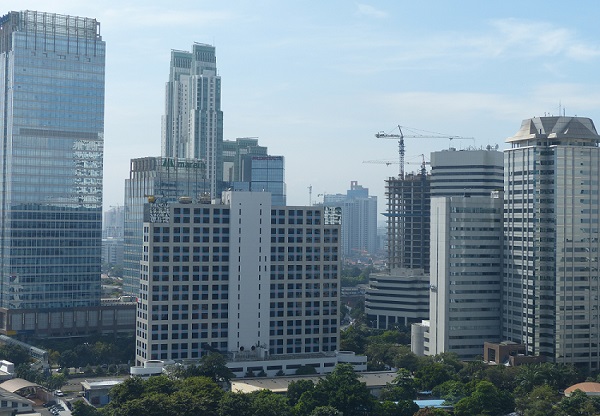Indonesia Needs +7% GDP Growth to Become High Income Country by 2030
In order to avoid the middle-income trap and join the ranks of the high income countries by 2030 (reaching a per capita income level of at least USD $12,500), Indonesia needs to raise economic growth beyond the 7 percent year-on-year (y/y) level. If the current gross domestic product (GDP) growth rate is maintained (between 5 and 6 percent y/y) then it will take another decade to break from the middle income trap and become a high income country. However, GDP growth in 2014 is projected at a bleak 5.2 percent (y/y).

Amid global economic turmoil and domestic rebalancing of the economy, GDP growth of Indonesia has slowed considerably since 2011. In the third quarter of 2014 economic expansion of Southeast Asia’s largest economy touched a five-year low at 5.01 percent (y/y). Capital outflows triggered by the US Federal Reserve’s monetary tightening (giving rise to a depreciating rupiah exchange rate) and accelerated inflation in Indonesia (after two subsidized fuel price hikes in the past two years) made the central bank of Indonesia (Bank Indonesia) decide to raise its key interest rate (BI rate) gradually (from 5.75 percent in June 2013 to 7.75 percent in November 2014) thus deliberately curbing economic growth in order to safeguard the country’s financial fundamentals.
The recent fuel price hike (raising prices of low octane gasoline and diesel by an average of 34 percent) conducted by the Joko Widodo-led government was praised by various national and international institutions as it will provide more fiscal room for the government to invest in structural and long term economic and social development of the country (such as infrastructure, agriculture, healthcare and education). Although this move will lead to accelerated inflation and a higher interest rate environment (curtailing higher economic growth) on the short term, it is expected to result in higher economic growth in the longer term. As such, GDP growth projections for 2015 point to 5.8 percentage point growth (y/y) and Indonesian Finance Minister Bambang Brodjonegoro said that a +7 percentage point growth is possible starting from 2016 provided that external factors are conducive. In 2015 economic expansion of Indonesia will be negatively impacted by the Federal Reserve’s monetary normalization policy as this will trigger capital outflows from emerging markets, particularly those markets that cope with a wide current account deficit (Indonesia’s current account deficit will ease slightly this year to about 3 percent of GDP).
Indonesia's Quarterly GDP Growth 2009–2014 (annual % change):
| Year | Quarter I |
Quarter II | Quarter III | Quarter IV |
| 2014 | 5.22 | 5.12 | 5.01 | |
| 2013 | 6.03 | 5.89 | 5.62 | 5.78 |
| 2012 | 6.29 | 6.36 | 6.16 | 6.11 |
| 2011 | 6.45 | 6.52 | 6.49 | 6.50 |
| 2010 | 5.99 | 6.29 | 5.81 | 6.81 |
| 2009 | 4.60 | 4.37 | 4.31 | 4.58 |
Source: Statistics Indonesia (BPS)
Gross Domestic Product of Indonesia 2006-2013:
| 2006 | 2007 | 2008 | 2009 | 2010 | 2011 | 2012 | 2013 | |
| GDP (in billion USD) |
285.9 | 364.6 | 432.1 | 510.2 | 539.4 | 706.6 | 846.8 | 878.0 |
| GDP (annual percent change) |
5.5 | 6.3 | 6.1 | 4.6 | 6.1 | 6.5 | 6.2 | 5.8 |
| GDP per Capita (in USD) |
1,643 | 1,923 | 2,244 | 2,345 | 2,984 | 3,467 | 3,546 | 3,468 |
Sources: World Bank, International Monetary Fund (IMF) and Statistics Indonesia (BPS)
Finance Minister Brodjonegoro said that economic growth beyond 10 percent (y/y), as had been experienced by China, is highly unlikely in the future because global competition for foreign capital has heightened. Not only developing countries but also developed countries are in search of foreign investment as the lack of liquidity now also hurts these developed countries, prompting central banks to provide stimulus.
Indonesia is currently categorized as a lower middle income country with per capital GDP of USD $3,468 in 2013. A recent World Bank report revealed that Indonesia needs to implement six reforms in order to avoid the middle income trap:
1) close the infrastructure gap
2) close the skills gap
3) well-functioning markets
4) access to quality service for all
5) improving social protection
6) natural risk management
Further Reading:
• World Bank Report: How Can Indonesia Avoid the Middle Income Trap?
• World Bank Report: Indonesia Avoiding the Trap
• Avoiding the Middle Income Trap; a Presentation by Ndiame Diop
• Analysis of Indonesia's Gross Domestic Product
